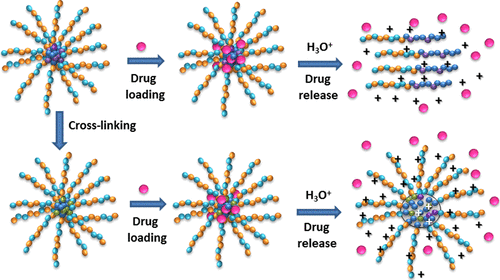Our official English website, www.x-mol.net, welcomes your feedback! (Note: you will need to create a separate account there.)
Validation of Smart Nanoparticles as Controlled Drug Delivery Systems: Loading and pH-Dependent Release of Pilocarpine
ACS Omega ( IF 4.1 ) Pub Date : 2018-01-11 00:00:00 , DOI: 10.1021/acsomega.7b01421 Elsa Galbis 1 , Nieves Iglesias 1 , Ricardo Lucas 1 , Ernesto Tinajero-Díaz 2 , M.-Violante de-Paz 1 , Sebastián Muñoz-Guerra 2 , Juan A. Galbis 1
ACS Omega ( IF 4.1 ) Pub Date : 2018-01-11 00:00:00 , DOI: 10.1021/acsomega.7b01421 Elsa Galbis 1 , Nieves Iglesias 1 , Ricardo Lucas 1 , Ernesto Tinajero-Díaz 2 , M.-Violante de-Paz 1 , Sebastián Muñoz-Guerra 2 , Juan A. Galbis 1
Affiliation

|
Micelles are good devices for use as controlled drug delivery systems because they exhibit the ability to protect the encapsulated substance from the routes of degradation until they reach the site of action. The present work assesses loading kinetics of a hydrophobic drug, pilocarpine, in polymeric micellar nanoparticles (NPs) and its pH-dependent release in hydrophilic environments. The trigger pH stimulus, pH 5.5, was the value encountered in damaged tissues in solid tumors. The new nanoparticles were prepared from an amphiphilic block copolymer, [(HEMA19%-DMA31%)-(FMA5%-DEA45%)]. For the present research, three systems were validated, two of them with cross-linked cores and the other without chemical stabilization. A comparison of their loading kinetics and release profiles is discussed, with the support of additional data obtained by scanning electron microscopy and dynamic light scattering. The drug was loaded into the NPs within the first minutes; the load was dependent on the degree of cross-linking. All of the systems experienced a boost in drug release at acidic pH, ranging from 50 to 80% within the first 48 h. NPs with the highest degree (20%) of core cross-linking delivered the highest percentage of drug at fixed times. The studied systems exhibited fine-tuned sustained release features, which may provide a continuous delivery of the drug at specific acidic locations, thereby diminishing side effects and increasing therapeutic rates. Hence, the studied NPs proved to behave as smart controlled drug delivery systems capable of responding to changes in pH.
中文翻译:

智能纳米颗粒作为药物控制系统的验证:毛果芸香碱的负载和pH依赖性释放
胶束是用作受控药物递送系统的良好装置,因为它们展现出保护包封的物质免受降解途径的能力,直到它们到达作用部位为止。本工作评估了疏水性药物毛果芸香碱在聚合物胶束纳米颗粒(NPs)中的负载动力学及其在亲水环境中的pH依赖性释放。触发pH刺激pH值为5.5,是实体瘤受损组织中遇到的值。由两亲嵌段共聚物[[(HEMA 19% -DMA 31%)-(FMA 5% -DEA 45%)]。对于本研究,验证了三个系统,其中两个具有交联的核,另一个没有化学稳定性。在通过扫描电子显微镜和动态光散射获得的其他数据的支持下,讨论了它们的负载动力学和释放曲线的比较。在最初的几分钟内将药物加载到NP中。负载取决于交联度。在最初的48小时内,所有系统在酸性pH下的药物释放均得到增强,范围从50%到80%。核心交联度最高(20%)的NP在固定时间交付的药物百分比最高。所研究的系统具有微调的缓释功能,可以在特定的酸性位置连续递送药物,从而减少副作用并提高治疗率。因此,被研究的NP被证明表现为能够响应pH变化的智能控制的药物递送系统。
更新日期:2018-01-11
中文翻译:

智能纳米颗粒作为药物控制系统的验证:毛果芸香碱的负载和pH依赖性释放
胶束是用作受控药物递送系统的良好装置,因为它们展现出保护包封的物质免受降解途径的能力,直到它们到达作用部位为止。本工作评估了疏水性药物毛果芸香碱在聚合物胶束纳米颗粒(NPs)中的负载动力学及其在亲水环境中的pH依赖性释放。触发pH刺激pH值为5.5,是实体瘤受损组织中遇到的值。由两亲嵌段共聚物[[(HEMA 19% -DMA 31%)-(FMA 5% -DEA 45%)]。对于本研究,验证了三个系统,其中两个具有交联的核,另一个没有化学稳定性。在通过扫描电子显微镜和动态光散射获得的其他数据的支持下,讨论了它们的负载动力学和释放曲线的比较。在最初的几分钟内将药物加载到NP中。负载取决于交联度。在最初的48小时内,所有系统在酸性pH下的药物释放均得到增强,范围从50%到80%。核心交联度最高(20%)的NP在固定时间交付的药物百分比最高。所研究的系统具有微调的缓释功能,可以在特定的酸性位置连续递送药物,从而减少副作用并提高治疗率。因此,被研究的NP被证明表现为能够响应pH变化的智能控制的药物递送系统。


























 京公网安备 11010802027423号
京公网安备 11010802027423号